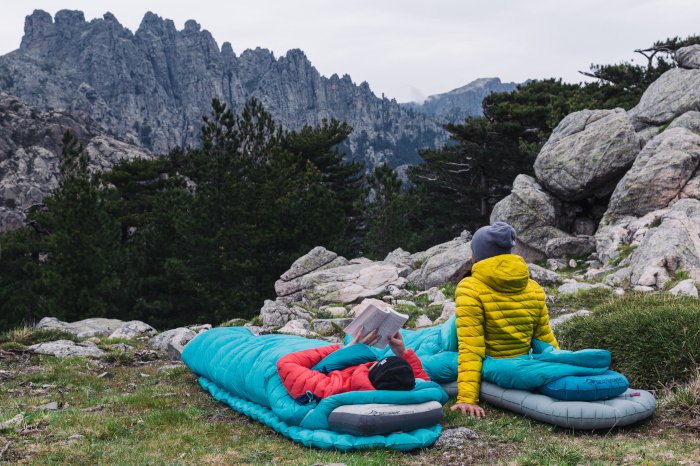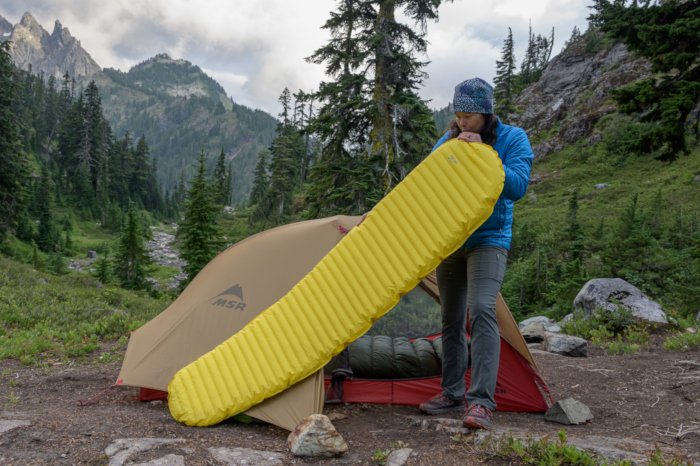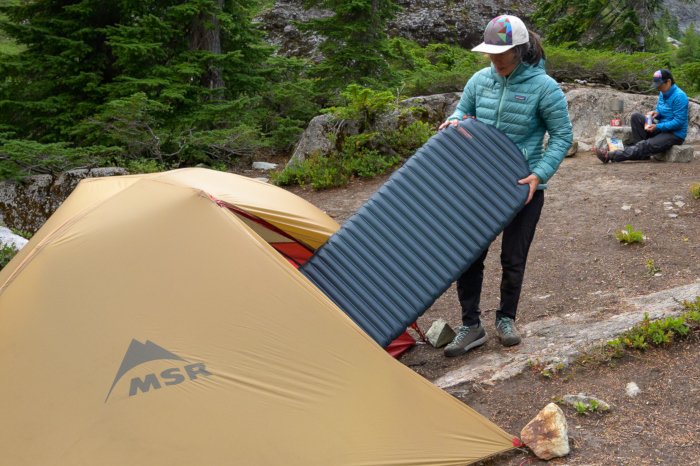Insulation, comfort, dimensions, weight and price are among the criteria to consider when buying a backpacking sleeping mat. Glisshop is here to help, we want to make sure you ask yourself the right questions before taking your decision. This guide is the base camp for your search for the right sleeping mat.

Main takeaways
- A bivouac sleeping mat provides comfort and insulation from the ground.
- Choose according to your activity: occasional camping or demanding trekking.
- Match the mat to the season using the R-Value rating.
- Determine your priority: comfort or lightweight design.
- Check the inflated dimensions and packed size for ease of transport.
- Weight ranges from 200 g to 1 kg depending on performance and durability.
- The R-Value indicates the level of thermal insulation.
- Durability depends on the fabric (denier rating, nylon, polyester, ripstop construction).
- Choose between inflatable and self-inflating models depending on your needs.
- A repair kit is essential for long-distance trekking.
Why is a backpacking sleeping mat necessary?
The answer is simple, you might say: to sleep well. And you’re right! After a long, maybe tiring day of hiking, it is important to rest. In the same way as your clothes, footwear and your tent, a quality hiking sleeping pad is an essential piece of equipment.
The other advantage of a sleeping mat, is the insulation from the cold and moisture it provides, preventing you from shivering all night long. Whether you’re a recreational or more serious hiker, a good night’s sleep is critical to be ready for the next day. Sleeping well is the only way to wake up on the right side of the bed, or sleeping pad in this case. Depending on the type of your hikes, you’ll need a backpacking mat with the right comfort/performance ratio.
Asking yourself the right questions before buying
What kind of hiking do you do?
To find the right model, this is the first question to answer. It is much easier to choose your sleeping mat according to your use. If you plan on backpacking occasionally for a night or two, your needs are not the same as for a long trek in extreme conditions. Don't worry, we’ll tell you everything you need to know to make the right decision.

3 or 4 seasons, when do you plan on bivvying?
While most sleeping mats are designed for late spring to early autumn use, there are some 4 season mats that will protect you from the cold ground on winter expeditions. The R-Value, which will talk about later, indicates the insulation level of your sleeping mat. In addition, while in summer you can sometimes put comfort aside, in winter, having the wrong mattress can be (very) dangerous.
Comfort of lightness, what are your priorities?
Integrating these various elements in the buying process will allow you to find the right weight/performance ratio! While someone new to backpacking will look for the best sleep quality, a seasoned hiker will want a compact and lightweight sleeping mat, just like the rest of his/her equipment, to fully enjoy the wonderful landscapes visited around the globe. Of course, the price is another key element, ultra-lightweight gear being more expensive!
Which backpacking sleeping mat to sleep under a tent?
If you love spending nights outdoors, in forests, on the seaside or in mountains, but only under a tent, your backpacking sleeping mat has to be comfortable, to make your micro-adventure as enjoyable as possible. In this case, weight is not the priority, the hiking part being rather short. An ultra-compact mat is not critical either. For a short adventure, you need less equipment than for a long backpacking trip or trek. As a consequence, you can choose comfort over lightness!
Which sleeping mat for a long distance trek?
Backpacking sleeping mats are designed for more experienced hikers looking for a compact and lightweight mat, that won’t encumber your backpack. Intensive use on treks will require a durable sleeping mat that can withstand the sometimes-rugged terrain you may have to sleep on. Choose a model with an optimal comfort/performance ratio to sleep like a baby and have enough room in your backpack for the rest of your gear.
Our tip: on your backpacking adventures, carry a repair kit in addition to your mat. It easily fits in your backpack and can save the day, well the night, in case of a puncture.

The criteria to choose a backpacking sleeping pad
Dimensions
The dimensions of your sleeping pad are essential to consider. Make sure the inflated length is at least 10 centimetres more than your height, to provide enough space and better comfort. The same applies to the width of your sleeping mat. In addition, carefully look at the thickness. More air volume means better the insulation and more warmth.
The other dimensions to consider, are the ones of your sleeping mat when packed in its stuff sack. Indeed, some mattresses can be bulky and some are much more compact and easier to fit in your backpack.
Memo:
- Length: choose a sleeping mat at least 10 cm longer than your height to ensure proper support.
- Width: opt for a width suited to your body size to prevent heat loss along the sides.
- Thickness: the more air a mat contains, the better its insulation against ground cold.
- Packed size: check the volume once folded; some models compress very efficiently into a rucksack.
Weight
This is an important element, but be cautious, the term ultra-light is trendy and can be used wrongly on numerous items by the outdoor industry. Depending on the type, weights range from 200 g to 1 kg. In this limited bracket you can find good and bad models. Buying your sleeping mat from Glisshop guarantees you to pick a high-quality model selected and approved by our hiking experts!
R-Value: thermal resistance rating to be ready for winter
The R-Value is the thermal resistance rating of your sleeping mat. Ranging from 1 to 6, it allows to identify at a glance the seasonality of the model.
- R 1 to 2: Ratings between 1 and 2 correspond to summer use, in fair weather conditions. Low insulation but lightweight and compact.
- R 2 to 4: A sleeping mat with an R-Value between 2 and 4 corresponds to 3 season use. It will work from spring to autumn, in cooler conditions. The closer to 4 the rating gets, the more you can use the mat in early winter.
- R 4 to 6: These ratings indicate 4 season use. Minimal heat loss for winter backpacking.
- R 6: Finally, for the most daring adventurers, looking to go on polar or high-altitude expeditions, an R-Value of 6 or more is required to sleep safely, even in the most extreme conditions. Of course, these mats are the most expensive ones.
Durability
The durability of your sleeping pad is critical for intensive use or if you are planning a long-distance adventure on various terrains. It mostly depends on the fabrics used. Deniers refer to the thickness of the individual fabric threads. A 40D nylon sleeping mat is not as strong as the 75D polyester one. Finally, Ripstop is synonym of better abrasion resistance.

Inflatable or self-inflating, which system is better?
The choice between an inflatable mat or self-inflating mat depends on your use. Multiple systems exit:
- Some inflatables mats are supplied with a built-in electric pump which is of course very practical, but is bulky and adds some weight.
- Some inflatable pads come with a pump-sack, which avoids breath inflation and prevents moisture from getting inside.
- Breath inflation may make you feel dizzy, but has the advantage of not requiring a pump.
- Finally, the last option is a self-inflating mat, handy for frequent use and quick to inflate and deflate.
Foam trekking mats
The foam sleeping mat is the simplest and most economical option for bivvying. Lightweight, durable and quick to set up, it remains a solid choice for hikers on a budget or those who favour a minimalist approach. Often foldable in an accordion style, it provides decent insulation thanks to its closed-cell structure, although comfort is limited compared with inflatable models.
Advantages:
- Very affordable price
- Ultra-lightweight
- Highly resistant to tears and punctures
- Instant setup
Disadvantages:
- Bulky when packed or attached to the rucksack
- Basic comfort level
- Moderate insulation (R-Value between 1 and 2)
Comparison table: foam, inflatable and self-inflating sleeping mats
| Criteria/Type | Foam mat | Inflatable mat | Self-inflating mat |
|---|---|---|---|
| Principle | Folded or rolled foam | Mat inflated with air | Internal foam + air |
| Price | Very economical | Varies, often more expensive | Reasonably priced |
| Weight | Lightweight | Light to ultralight depending on model | Moderate weight |
| Packed size | Bulky (often strapped outside the pack) | Very compact when packed | More compact than foam, less than inflatable |
| Comfort | Basic, limited | Very comfortable (thick, cushioned) | Intermediate comfort, sometimes limited on hard ground |
| Insulation (R-Value) | Low: 1 to 2 | Varies by model: 1.5 to about 4.5 | Up to 4 for some models |
| Recommended seasons | Summer / mild temperatures | Summer to 4-season use depending on R-Value | Mainly 3-season use |
| Inflation | None | By mouth, pump sack or pump | Self-inflating + a few breaths |
| Setup speed | Instant | Longer (requires inflation) | Quick |
| Durability / robustness | Very high, cannot be punctured | Fragile (risk of puncture) | Fairly robust but sensitive to valves/leaks |
| Recommended use | Low budget, beginners, abrasive ground, safety | Long treks, extended comfort, minimal bulk | 3-season hiking, regular use, family camping |
The best hiking mattress brands are at Glisshop!
Discover our full range of all-season sleeping mats available now on our online store. Glisshop offers products from the most renowned outdoor brands, so you can head out on your adventures with top-quality gear. To take your bivvy preparation even further, feel free to check out our tips on how to choose the right sleeping bag as well as our buying guide dedicated to trekking tents.
